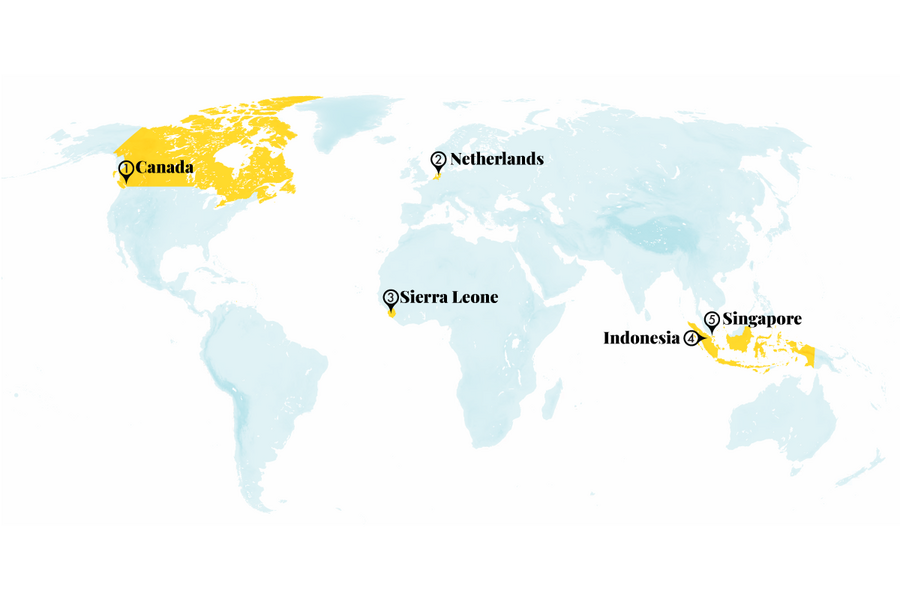From Netherlands to Indonesia, solutions for safer and snugger homes
Loading...
1. Canada
A study that gave cash payments to homeless people is upending stereotypes. Researchers at the University of British Columbia gave 50 participants in Vancouver unconditional cash transfers of $7,500 (Canadian; U.S.$5,600) and tracked their spending for a year. They found that individuals mostly spent the money on food, housing, transit, clothes, and other essentials.
The results contrast with public perceptions that unhoused people would spend more money on “temptation goods” such as drugs and tobacco.
Why We Wrote This
Our progress roundup highlights very different ways of improving life at home. In Indonesia, GPS-outfitted elephants are helping residents keep track of nearby herds. And a novel energy retrofit from the Netherlands uses custom-made components installed on the fronts of row houses.
Lump-sum transfers were made rather than several smaller ones, to maximize freedom of choice. Recipients spent 99 fewer days unhoused than the control group. The study also found that participants increased their savings and reduced the need for public spending by about $777 (Canadian; U.S.$580) per person.
The majority of homeless people are not challenged by serious substance misuse or other mental health disorders, and the study did not include such individuals. Conducted in a high-income nation, the research adds to studies in Kenya, Zambia, and Pakistan that have found that unconditional cash transfers can reduce poverty and empower disadvantaged groups.
Sources: The Guardian, The Washington Post, Proceedings of the National Academy of Sciences
2. Netherlands
With a net-zero energy goal for each home, the nonprofit Energiesprong (energy jump) is accelerating retrofits with prefabricated components – giving old buildings a new, insulated face. In 2010, the Dutch government helped launch Energiesprong, which installs rooftop solar, heat pumps, and new facades. An old building is measured by a laser scanner, and the new factory-made facade placed on the home’s front includes insulated windows and doors. The concept is ideally suited to uniform building designs and old row houses.
The retrofits are designed so that a house produces as much renewable energy as it uses. Out of 5,700 homes retrofitted in the Netherlands, houses in the city of Utrecht in 2019 saw a 78% decrease in energy use. In Mönchengladbach, Germany, a pilot program is demonstrating that the retrofits take about three months, four times as fast as a conventional renovation.
Energiesprong concepts are being adapted in the United Kingdom, France, Italy, Canada, and the United States. For global climate targets to be met in coming decades, an estimated 3 million to 6 million homes in the U.S. alone would need to be decarbonized every year. Costs can be high for property owners, but government subsidies are part of some programs, and lower utility bills can also help offset renovation costs.
Sources: Bloomberg, Fast Company, Energiesprong
3. Sierra Leone
A maternity center built mostly by women in Sierra Leone will expand care and help train the next generation of health care providers. In a country with one of the highest maternal mortality rates in the world – 717 deaths per 100,000 live births – Sierra Leone’s government and the nonprofit Partners in Health are constructing a 166-bed facility that will complement the teaching hospital next door.
The center, in the Kono District of Eastern Province, was designed by another nonprofit, Build Health International, which prioritizes hiring local talent. The construction team is now 60% women, after the first woman hired began to recruit others to apply. “We, as women, can also stand up for our rights and do this type of work that is considered to be for men only in Sierra Leone,” said Florence Saffea, the tool depot manager.
The teaching hospital had already garnered a favorable reputation owing to improvements such as round-the-clock electricity. New goals include increasing family planning visits fivefold and continuing to reduce maternal deaths. The new center’s design also adapted to local needs, including spaces to accommodate community members helping with care.
“It is for us, the women who will give birth here,” said Hawa Baryoh, who works on quality control. “That’s why we are putting in effort to build the hospital.”
Sources: The Guardian, Build Health International
4. Indonesia
An Indonesian nonprofit is reducing conflicts between elephants and humans using GPS collars. Since palm oil and paper plantations, farming, and logging began threatening their habitats in the 1990s, Sumatran elephants have been forced closer to where people live. In 2016, a herd of 30 spent two months eating its way through a village’s cropland in Riau province on the island of Sumatra.
Three years ago, Rimba Satwa Foundation (RSF) began using GPS and now works every day tracking five of the nine herds on the island. By sedating the elephant that leads a herd and fitting it with a 30-pound GPS collar, conservationists can alert villagers if the animals tread near. Locals can then use firecrackers and other loud noises to drive the herd away. No violent interactions have occurred in the past year.
RSF’s work is part of a broader effort to reduce human-animal skirmishes in other countries as well, in part by using drones and sensors that set off alarms. In Liberia, an audio device frightens elephants away from settlements by imitating buzzing bees.
It’s currently a labor-intensive operation, but RSF hopes to tag remaining herds and introduce more technology to improve surveillance.
Source: Rest of World
5. Singapore
Singapore is combating e-waste with an “extended producer responsibility” law and grassroots community repair. The United Nations estimates that humans produce 57 million metric tons and growing of electronic waste annually – only about 20% of which is recycled. And in Singapore, a densely populated city-state with a single landfill, both citizen and government efforts are tackling the problem to stem harm to the environment and human health.
The Resource Sustainability Act requires manufacturers, importers, and retailers whose stores are at least 3,200 square feet to collect discarded electronics from consumers and properly channel them for recycling. It excludes some smaller household appliances, such as rice cookers and electric kettles.
That’s where Repair Kopitiam comes in. In the community-driven initiative, volunteers gather weekly to help other Singaporeans fix and reuse defunct electronics of all kinds.
When they first saw a surge of air fryers, volunteers didn’t know how to fix them. “A few of our veterans came together and figured it out,” said Danny Lim, a mechanical engineer at the program. “And, now we are fixing air fryers. It’s a learning process for us too.”
The program seeks to expand and empower more neighborhoods in Singapore.
Source: Mongabay










